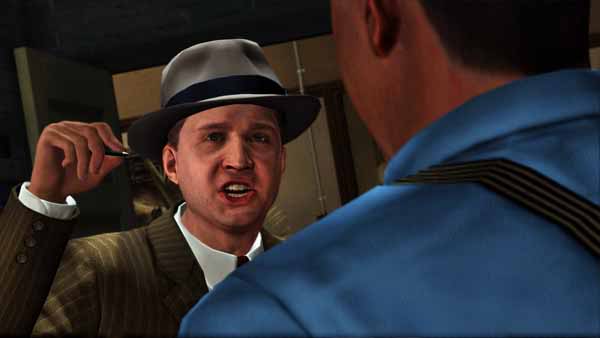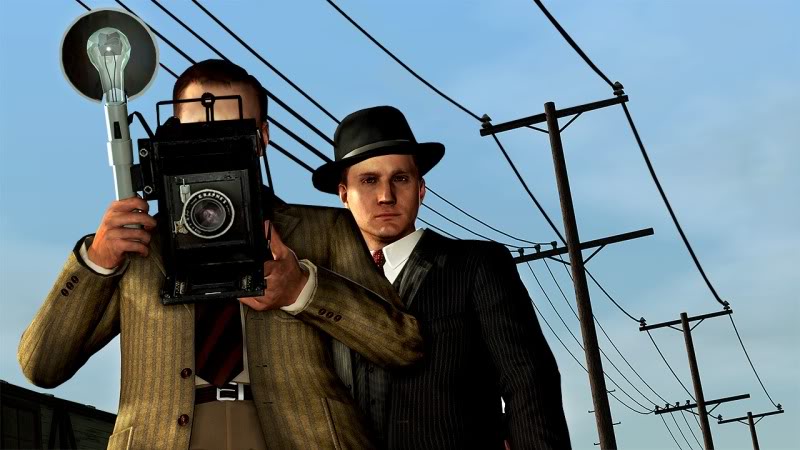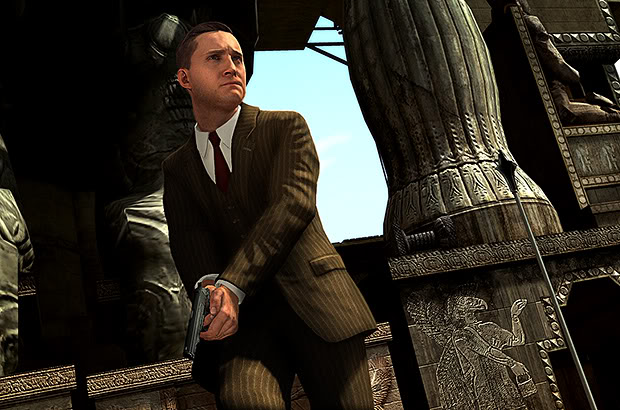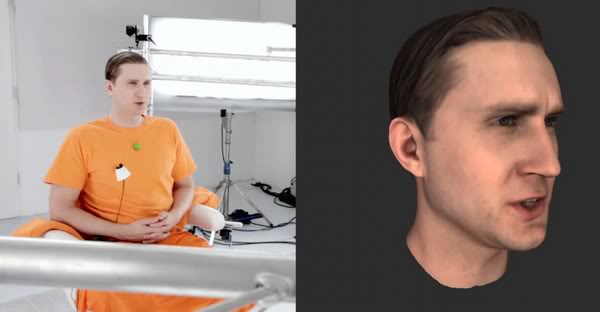With the sea of new big titles approaching release this fall, the video game drought of the year gave plenty of time for some players to catch up on the games that had already been released. One such title that garnered a reputation and received a great deal of acclaim that was worth visiting during the drought was L.A. Noire. Hailed as a unique experience unlike any other, it was the newest title to proudly (at the time) wear the Rockstar label and already got people whispering “game of the year.” But was it worthy of that title or even all the praise it received? Or was it just a series of concepts hidden under a stylish guise as displaced and forgotten as the time period itself?
Story
You play as Cole Phelps, a WWII veteran fresh off the boat and onto the police force. Just a short time on the street with a badge and Phelps finds himself knee deep in detective work. This naturally gets the attention of the right or wrong people and he starts his glorious climb up the ladder of the police hierarchy, uncovering and solving huge cases and conspiracies and making plenty of enemies in the process.
In terms of an overall story in L.A. Noire, there isn’t much of one. Rather, it’s a series of different story arcs that end by the time that “desk” is completed. Many of the small story arcs are quite interesting with some real head-scratchers and the occasional case that spills over into a side-mission or one that continues on to the next story mission. Sometimes this happens a little too often, though. Solving one case after another that is identical to the last, according to the guidelines of the mission can feel tedious and drags the story a bit. Also, when the writing on the wall is clear as day that everything that is “successful” is, in fact, wrong the completion of the case feels rather hollow.
Besides the investigations, there are some plot pieces that are happening concurrently via newspapers that can be found in the world, as well as some flashbacks pertaining to Cole’s military experience. There are details that connect all these little variables together, but they are tied rather loosely. As the game starts to build towards a conclusion all the points start to align and the links between characters start to become clear. But as for a straight story plot, the game doesn’t really have one outside of the character profile of Cole Phelps and maybe one other character that slowly steals the show.
Even in terms of character profiles, it’s layered on rather thin. Players get flashbacks pertaining to Phelps and his time in the war as well as random in-game cinemas that play scenes in relation to characters that haven’t been really introduced directly to the story. All these flashbacks and scenes that take place away from the actual crime investigating make it seem like there is some big story to drive the game toward. Unfortunately, the big stories that are uncovered never really get much of a conclusion and much of the story of L.A. Noire ends up being unsatisfying as much of it remains unfinished by the game’s conclusion.
That isn’t to say there are some redeeming qualities in the story. There are truly some shining moments in the game that stand out and show a real understanding of characterization and depth of feeling. The characters, while many are archetypes taken straight out of movies like LA Confidential, are still convincing in their portrayals. Their emotions come out in full force with dialogue that can completely pull you into the scene. Some of the moments in the game are truly stunning with great lines delivered with fervor and force that really can make you root for a character’s success. Nothing is quite as entertaining as a man kicking down the door opening fire directly a suspect and yelling, “That is my first negotiating option!”

The true tragedy of this game’s story writing is the conclusion to it all. The writers obviously took very good notes for the set-up and climax part of writing class, but must have skipped the one that focused on the conclusion section. Everything that ends, be it a small arc or a big chunk of the story, ends in an abrupt way.
Interruptions like job promotions come suddenly and at awkward moments. Sometimes it decides to change the story right then and there despite the investigation finally getting interesting and fun. It seems like this game would have benefitted from just a few more missions to stretch out some mechanics and a few more moments in the story to let things settle so the conclusions to different pieces of the story didn’t feel so rushed.
Mechanics
While being hailed for being something completely new and innovative, L.A. Noire’s gameplay was far from mind-blowing. Essentially the game can be broken down to a point-click adventure similar to games the Monkey Island series, with some third-person shooting and RPG elements mixed in for the console experience. When it comes to the primary portion of the gameplay, each investigation is essentially split into 2 halves.
The game sets up the mechanics very early on and those mechanics don’t change much over the course of the game. Cole starts out as a lowly patrolman, but after having some small crimes thrust upon him, the tutorial sends players through the mechanics till Cole becomes a full-blown investigator. While investigating each scene, music plays in the background to show that the area is still active and in need of searching. A small vibration in the controller and a chime sound effect indicate that a possible clue is nearby and requires some inspection. When the scene has been scoured of all its clues, the music does a little finale with a chime similar to Zelda’s treasure sound, and Cole is given the option to leave the scene.
This all sounds like the makings for an interesting experience in the general sense, but the execution of the ideas leaves something to be desired in certain respects. Since the game is not a point and click adventure and since the clues one finds will not actually be used as an item later, there are many clues that do not sparkle or stand out much. Players are forced to wander the scene for many minutes just waiting for a rumble in the controller or a little chime. This makes sense in terms of being a detective and trying to find every clue you can find to make sure you can solve the case, but in terms of being a game, a fair amount of time is spent in the scene looking for the last clue that could be spent on something more interesting. And to make the experience more “realistic,” there are numerous items that catch Cole’s attention only to be empty glass bottles or something useless, which essentially gives the experience a little immersion at the price of patience. The developers probably knew this in advance and it’s much better than what it could have been where every little detail in the area needed to be turned over an inspected thoroughly.
What would be a solution to this situation? Removing the musical cue for when you’ve actually found all the clues is the simplest method. The completionist gamer is going to keep searching until that music finishes playing, but without any idea as to what clues have been found, he/she will not be able to distinguish when enough is enough. This would force players to become more creative or involved in their methods of inspecting a crime scene or be forced to return to it later for a clue that might be necessary to finishing the case.
Giving the player an opportunity for failure seems like it would create a much more involved experience. A game that did this with relative success was Heavy Rain. Heavy Rain was a game that had players investigating crime scenes and interrogating characters with lots of room for error. Should players not find all the clues or ask the wrong questions, oh well. If players messed up in a scene or even let a character die, the game kept moving. L.A. Noire doesn’t give the players as much leeway for their experiences. It won’t let the story continue until all the necessary pieces are assembled. The game is going to make sure players complete each task without fail. Even if the wrong suspect is charged with a crime, the game still has things written out for those mistakes not to matter much, making the impact of all the decisions players make for Cole feel hollow and superficial. It doesn’t really matter in the end anyway because players can always go back and replay old cases they’ve completed.

The other half of the investigation process would then lead to interrogating/questioning a witness. During the interview process, players choose a topic to discuss with the subject, and based on their reactions to the subject, the player chooses the next step to get the evidence or answer Cole is looking for. The next step is one of 3 choices: there is Truth is in what the subject is saying and all that is needed to get more is to ask nicely, Doubt that the whole truth is being said and forcibly extract an answer from them, or see the Lie in their words and catch them in it using evidence to disprove what they said.
What makes this experience more interesting than a simple guessing game is the facial recognition technology the developers used to make every character’s face show the muscle contractions or eye-darting that is common when people are lying. This would be much more interesting if it truly helped as well as the developers claimed it did. An eye-shift or shuffling in the chair eliminates the Truth option immediately in most cases, but not all of them. Meaning you cannot simply rely on the reactions of the suspects to get the indication on how to approach the next step. Players must also take into account the meaning behind selecting Truth, Doubt, or Lie (Be nice, be mean, use evidence). There are some instances where those meanings are more important than the methods you may have been using already. For instance, a character is constantly looking away and shifting in her chair, but the Truth option is still the right one because by being nice to her, you’re getting her to tell you more of the story.
This all leads to using a formula to eliminating each option. If the conversation leads you to believe that there is no evidence to support a Lie claim, then there is no reason to use that option. However, one cannot rely on the actions of the subjects during a question to determine if it’s Doubt or Truth, which brings it back to a guessing game. The way out of this was to use the option to back out of a Lie claim to see if the dialogue changes direction some way. In other words, Cole’s question could be very vague and the response too vague to really get any idea of how to continue. Accusing the subject of a lie moves the conversation along in a way that may make distinguishing what evidence to use more obvious. If not there is the option to back out of the accusation and use one of the other choices.
Again, the interrogation idea seems sound on paper or as a general idea. But as a mechanic in the game, once the formula is realized, the act of interrogating starts to feel really shallow. It ends up feeling like little more than exploiting the system when successful, and an extremely annoying experience when it fails because suddenly the game is no longer following the rules it established, as though the rules were changed out of convenience.
Gameplay
So those are the basic mechanics of the primary parts of the gameplay, but what about the rest? There are some other elements of gameplay added to this investigatory point-n-click adventure. After all, there has to be more than simply going from a crime scene to an interrogation room. There are driving sequences, shooting sequences, and puzzle moments in the big open world of Los Angeles.
The shooting feels similar to Red Dead Redemption. If you’ve just been playing out west and picked up L.A. Noire, the gunplay will be natural to pick up. There is a simple cover system and plenty of cover to use throughout the game. Parked cars can be used as cover so it isn’t limited simply by a specific object. There’s no ammo limit on the pistol Cole uses and the auto-aim function of the targeting that players cannot turn off makes the gunplay a common cakewalk. Even though Cole can’t take too many shots from a gun, any time death occurred during a gunfight in the game, it usually was due to being careless.
Beyond gunplay for the exciting moments in the game, there were the frequent chases. In both side-missions and moments essential to the plot, players will have to chase down their suspects either on foot or in a car. On foot chases were usually rather boring and simple in terms of just following the suspect through scripted series of events until the game either chooses to end the chase with another scripted event or you manage to take some tight enough turns to cut off the suspect and tackle him.
The same formula can be applied to the car chases. The game will never let a chase go on forever. Eventually the driver will make an intentional mistake and crash the vehicle if you are unable to subdue him or her via ramming your vehicle or allowing Cole’s partner to shoot out the tires. The car chases can be both fun and tedious. The cars themselves handle extremely well, despite being cars from an age where every vehicle was like driving a boat on the road. Most of the cars are fun to drive and sending the occasional suspect reeling or even flying through the air with a well-place slam into the rear wheel of your suspect’s car is immensely satisfying.
However, since every chase is scripted, the path never changes and opportunities for more unique experiences are limited. Not to mention that since both types of chases are scripted, there are moments where the game allows you to catch up with the suspect for an opportunity to stop them. But once that moment has passed, it’s unlikely for you to catch up with them again until the next time the game decides it. Naturally this makes it easier for trial and error should players fail, but it also loses some of the immersion with the fact that everything is done for the player. It’s as though developers were a little too concerned with who might pick up their game and trying their best to appeal to as wide an audience as possible rather than refining what they already had in mind.
Finally, there are the puzzle segments that show up in the game where Cole has to put a couple physical objects together to make sense of the puzzle. But these moments are so infrequent that they are easily overshadowed and forgotten in comparison to the frequent shootouts and car chases. Considering how much of the game is supposed to be an investigatory thriller, so much time is spent driving and shooting in an open world that feels more tacked on than truly flushed out, much of the role of a lone detective is lost with all the shots of gunfire.

It’s not necessarily bad gameplay, either. It’s just overused. So much of the game is repetitious that the lack of change in the game’s style really drags it down. The places where it broke out of the formula were the moments that really shined. (For the sake of not spoiling anything, details won’t be divulged.) The last case of the Homicide Desk was by far the most interesting one simply because of how much different it was from every case that had been investigated before. It actually forced players to really think about what the clues were telling them as opposed to what the game wanted the clues to tell them. It was irritating that if you didn’t come up with an answer within ten minutes the game told you the answer anyway, but it was such a welcomed change of pace. For the first time it felt like being the detective and not just the line to connect the dots in Cole’s head.
It’s too bad because there are some truly incredible moments where the direction and pacing feels spot on. These moments alone make the game worth playing, despite its shortcomings. Ominous environments, horrific crime scenes, and conspiracy plots are all elements of a story that can make the experience much more intense and immersive. But it’s nonetheless filled with derivative gameplay that functions, but takes away from the atmosphere in order to appeal to a wider audience. It’s surprising that a game like Heavy Rain, while far from perfect in its gameplay mechanics, maintained a deep foreboding atmosphere that was much less disappointing.
Presentation
L.A. Noire is definitely an impressive looking game. The facial recognition technology is unlike anything anyone has seen in games. Being able to see muscles in a person’s face change and using that type of physical rendering as a gameplay mechanic is something else entirely. And it isn’t as though only the main character’s got that level of detail; every NPC on the street has a realistic face. It makes the fact that sometimes the characters’ skin texture looks like it’s made out of plastic much more forgivable.

The vehicles that you spend so much time in throughout the game are also a sight to behold. With 90+ cars to drive in the game, each one is rendered with splendorous detail. Their designs are accurate for the models they portray and they even go by the official names of the cars that were driven during that time. They look good and handle so well, it’s almost a tragedy when an accident happens and the car gets damaged.
There really aren’t too many areas of the game where it looks bad. The character models themselves are less than spectacular with clothing that might as well had been the skin of the characters with how it moved and looked during close up segments. Details amongst the environment that had no impact on the investigation often were rendered with less detail, making it a little less impressive. But you almost have to be looking for these details to notice them.
Sound quality is also top notch. The radio music is straight out of that time period, with the occasional track that is that can be found in Fallout 3. The background music is appropriately tense and filled with the brooding trumpet sound that is typical for the genre. The only problem is that the music volume often overtakes the scene, sometimes muting the dialogue, so it’s suggested that the music be turned down in the options.
The sound outside of music is satisfying to listen to as well. The sounds of cars crunching, guns firing, and glass shattering is all very visceral. Even the vocabulary and slang spoken by the people of the city match the time period. There was a fair amount of dedication in trying to put players in that time period and in most respects it was worth it.
The voice acting itself is more than convincing. In some of L.A. Noire’s best moments, it’s the attitude and impact of the characters words that make a complete difference to how the scene appears. The actors who were in this game did their best to make their characters convincing and they certainly had to with the level of detail put into rendering a character’s face. If there’s an area that L.A. Noire truly shines, this is it.
Conclusion
L.A. Noire is a good game with its share of flaws in every aspect of the game. Does that mean that it’s not worth playing? Absolutely not. It is an experience that is hard to come by these days in video games. While the story and its various components can fall flat at times, it will continue to keep you guessing and interested enough to see it through to the end. But it might be better for your enjoyment to take it all in doses so that the game’s repetitive nature doesn’t drag down the experience too much.
7/10